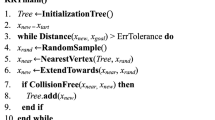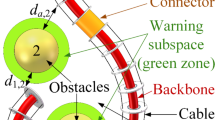Abstract
While cable-driven snake robots are promising in exploring confined spaces, their hyper-redundancy makes the collision-free motion planning difficult. In this paper, by combining the prediction lookup and interpolation algorithms, we present a new path following method for cable-driven snake robots to high-efficiently slither into complex terrains along a desired path. In our method, we first discretize the desired path into points, and develop the prediction lookup algorithm to efficiently find the points matched with joints of the robot. According to geometric relations between the prediction lookup results and link length of the robot, we develop the interpolation algorithm to reduce the tracking errors caused by the discretization. Finally, simulations and experiments of inspections in two confined spaces including the obstacle array and pipe tank system are performed on our custom-built 25 degree of freedoms (DOFs) cable-driven snake robot. The results demonstrate that the presented method can successfully navigate our snake robot into confined spaces with high computational efficiency and good accuracy, which well verifies effectiveness of our development.
Similar content being viewed by others
References
Buckingham R O, Graham A C. Dexterous manipulators for nuclear inspection and maintenance case study. In: Proceedings of the International Conference on Applied Robotics for the Power Industry. Montreal: IEEE, 2010
Axinte D, Dong X, Palmer D, et al. MiRoR—Miniaturised robotic systems for holistic in-situ repair and maintenance works in restrained and hazardous environments. IEEE/ASME Trans Mechatron, 2018, 23: 978–981
Li T, Ma S G, Li B, et al. Axiomatic design method to design a screw drive in-pipe robot passing through varied curved pipes. Sci China Tech Sci, 2016, 59: 191–202
Palermo E. Tesla unveils snakelike robot charger for electric cars. New York: Live Science, 2015. http://www.livescience.com/51791-tesla-electric-car-robot-charger.html
Wu J, Gao Y, Zhang B, et al. Workspace and dynamic performance evaluation of the parallel manipulators in a spray-painting equipment. Robotics Comput-Integrated Manufacturing, 2017, 44: 199–207
Cianchetti M, Ranzani T, Gerboni G, et al. Soft robotics technologies to address shortcomings in today’s minimally invasive surgery: The STIFF-FLOP approach. Soft Robotics, 2014, 1: 122–131
Li Z, Wu L, Ren H, et al. Kinematic comparison of surgical tendon-driven manipulators and concentric tube manipulators. Mechanism Machine Theor, 2017, 107: 148–165
Tang L, Wang J, Zheng Y, et al. Design of a cable-driven hyper-redundant robot with experimental validation. Int J Adv Robot Syst, 2017, 14: 1729881417734458
Wu J, Wang J, Wang L, et al. Dynamics and control of a planar 3-DOF parallel manipulator with actuation redundancy. Mechanism Machine Theor, 2009, 44: 835–849
Lau D, Oetomo D, Halgamuge S K. Generalized modeling of multilink cable-driven manipulators with arbitrary routing using the cable-routing matrix. IEEE Trans Robot, 2013, 29: 1102–1113
Lau D, Oetomo D, Halgamuge S K. Inverse dynamics of multilink cable-driven manipulators with the consideration of joint interaction forces and moments. IEEE Trans Robot, 2015, 31: 479–488
Mustafa S K, Lim W B, Yang G, et al. Cable-driven robots. In: Handbook of Manufacturing Engineering and Technology. Nee A Y C, ed. London: Springer, 2015. 2169–2228
Xu J H, Xiao M B, Ding Y. Modeling and compensation of hysteresis for pneumatic artificial muscles based on Gaussian mixture models. Sci China Tech Sci, 2019, 62: 1094–1102
Wu J, Yu G, Gao Y, et al. Mechatronics modeling and vibration analysis of a 2-DOF parallel manipulator in a 5-DOF hybrid machine tool. Mechanism Machine Theor, 2018, 121: 430–445
Tang L, Huang J, Zhu L M, et al. Path tracking of a cable-driven snake robot with a two-level motion planning method. IEEE/ASME Trans Mechatron, 2019, 24: 935–946
Zhang Z, Zheng L, Yu J, et al. Three recurrent neural networks and three numerical methods for solving a repetitive motion planning scheme of redundant robot manipulators. IEEE/ASME Trans Mechatron, 2017, 22: 1423–1434
Li M, Kang R, Branson D T, et al. Model-free control for continuum robots based on an adaptive kalman filter. IEEE/ASME Trans Mechatron, 2018, 23: 286–297
Liu T, Jackson R, Franson D, et al. Iterative Jacobian-based inverse kinematics and open-loop control of an MRI-guided magnetically actuated steerable catheter system. IEEE/ASME Trans Mechatron, 2017, 22: 1765–1776
Martin A, Barrientos A, del Cerro J. The natural-CCD algorithm, a novel method to solve the inverse kinematics of hyper-redundant and soft robots. Soft Robotics, 2018, 5: 242–257
Aristidou A, Lasenby J. FABRIK: A fast, iterative solver for the Inverse Kinematics problem. Graphical Model, 2011, 73: 243–260
Ananthanarayanan H, Ordóñez R. Real-time Inverse Kinematics of (2n+1) DOF hyper-redundant manipulator arm via a combined numerical and analytical approach. Mechanism Machine Theor, 2015, 91: 209–226
Chen Y, Cai Y, Zheng J, et al. Accurate and efficient approximation of clothoids using bézier curves for path planning. IEEE Trans Robot, 2017, 33: 1242–1247
Saha M, Isto P. Manipulation planning for deformable linear objects. IEEE Trans Robot, 2007, 23: 1141–1150
Miao Y J, Gao F, Zhang Y. Gait fitting for snake robots with binary actuators. Sci China Tech Sci, 2014, 57: 181–191
Tang L, Zhu L, Zhu X, et al. A serpentine curve based motion planning method for cable-driven snake robots. In: Proceedings of the 25th International Conference on Mechatronics and Machine Vision in Practice (M2VIP). Stuttgart: IEEE, 2018
Conkur E S. Path following algorithm for highly redundant manipulators. Robotics Autonomous Syst, 2003, 45: 1–22
Gill R J, Kulic D, Nielsen C. Spline path following for redundant mechanical systems. IEEE Trans Robot, 2015, 31: 1378–1392
Garriga-Casanovas A, Rodriguez y Baena F. Complete follow-the-leader kinematics using concentric tube robots. Int J Robotics Res, 2018, 37: 197–222
Palmer D, Cobos-Guzman S, Axinte D. Real-time method for tip following navigation of continuum snake arm robots. Robotics Autonomous Syst, 2014, 62: 1478–1485
Tanaka M, Tanaka K, Matsuno F. Approximate path-tracking control of snake robot joints with switching constraints. IEEE/ASME Trans Mechatron, 2015, 20: 1633–1641
Andersson S B. Discretization of a continuous curve. IEEE Trans Robot, 2008, 24: 456–461
Wang J, Tang L, Gu G, et al. Tip-following path planning and its performance analysis for hyper-redundant manipulators. J Mech Eng, 2018, 54: 18–25
Author information
Authors and Affiliations
Corresponding author
Additional information
This work was supported by the National Natural Science Foundation of China (Grant Nos. 51435010, and 91848204).
Electronic supplementary material
Supplementary material, approximately 24.0 MB.
Supplementary material, approximately 157 MB.
Rights and permissions
About this article
Cite this article
Tang, L., Zhu, L., Zhu, X. et al. Confined spaces path following for cable-driven snake robots with prediction lookup and interpolation algorithms. Sci. China Technol. Sci. 63, 255–264 (2020). https://doi.org/10.1007/s11431-019-1440-2
Received:
Accepted:
Published:
Issue Date:
DOI: https://doi.org/10.1007/s11431-019-1440-2




